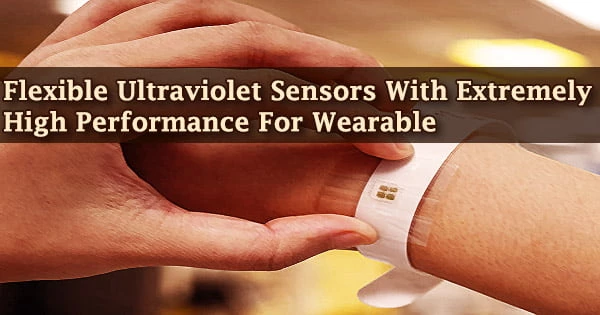Scientists at Nanyang Technological University, Singapore (NTU Singapore) have developed a new form of light sensor that is both flexible and very sensitive to enable the development of wearable gadgets with improved ultraviolet (UV) detecting functions.
While UV rays are invisible to the naked eye, they are present in our surroundings and can cause health problems such as skin cancer and premature skin aging. During weather reports, the intensity of UV radiation is usually expressed as an index.
A wearable device, such as a T-shirt or watch, that tracks a person’s actual UV exposure throughout the day would be a more useful and accurate guide for people trying to avoid sun damage.
The NTU researchers reported that their flexible UV light sensors were 25 times more responsive and 330 times more sensitive than existing sensors, exceeding the performance level required for optoelectronic applications of light-based electronics in their study, which was featured on the front cover of the peer-reviewed journal ACS Nano.
UV light sensors, also known as photodetectors, can be used in everything from cellphones to biomedical imaging.
Gallium nitride (GaN) has risen to popularity in recent decades as the best material for making UV light sensors, owing to its exceptional capabilities in emitting, controlling, transmitting, and sensing light.
Most GaN-based UV sensors are built on stiff layers today, which limits their applicability in flexible and wearable products.
While other researchers have created flexible GaN-based UV sensors, they have not yet reached the level of performance required for state-of-the-art applications. Low sensitivity and low responsivity are two of their greatest problems.
NTU’s invention overcomes the limitations of rigid UV light sensors
The NTU team overcame these limitations by fabricating their flexible UV light sensors on an 8-inch-diameter semiconductor wafer using free-standing single-crystalline layers of GaN and aluminum gallium nitride (AlGaN), which were arranged using membranes made up of two different thin semiconductor layers (heterostructure membranes).
This sort of semiconductor structure allows the material to be easily bent, making it excellent for use in flexible sensors. It can be produced using existing industrially compatible technologies.
While the performance of the rigid form of GaN-based UV light sensors has been greatly improved with various structural innovations over the past years, a flexible version remains in its infancy and their performance is far behind that of the rigid counterparts.
Asst Prof Kim
Simultaneously, the chemical makeup of the material changes with depth, ensuring that good performance is maintained even when under stress.
The NTU flexible UV light sensors produced with the new combination AlGaN and GaN performed at extremely high levels of responsivity and sensitivity in lab tests. They also performed well when subjected to various bending and high-temperature tests.
The sensors recorded a responsivity level of between 529 1340 Ampere/Watt (the unit used to measure the ability of a device to transfer an optical signal to an electrical signal) under a variety of external strains (compressive, flat, and tensile), which is about 100 times higher than existing UV sensors. After 100 cycles of repetitive bending, the responsiveness remained stable, indicating that it might be used in wearable.
Innovation opens door to UV-enabled flexible wearable tech
The high performance of the team’s flexible UV light sensors, according to lead researcher NTU Assistant Professor Kim Munho of the School of Electronic and Electrical Engineering, demonstrates that large-scale lightweight and flexible electronics for use in future relevant light-based applications is possible.
According to Asst Prof Kim, the NTU team’s achievement could lead to substantial advances in UV optoelectronic devices and circuits, as product engineers can now design UV-enabled wearable systems.
“While the performance of the rigid form of GaN-based UV light sensors has been greatly improved with various structural innovations over the past years, a flexible version remains in its infancy and their performance is far behind that of the rigid counterparts,” said Asst Prof Kim.
“Our high-performance flexible UV light sensors that we have created pave the way forward for a wide range of future wearable applications, such as in personal smart health monitoring, where people can accurately measure their UV exposure levels throughout the day to reduce their risk of skin cancer.”
Overexposure to UV radiation from the sun is the primary cause of skin cancer, which is one of the most common types of cancer worldwide. According to data published by the World Cancer Research Fund, about 2 in 3 persons in Australia, which has the highest rate of skin cancer in the world, will be diagnosed with skin cancer by the time they reach the age of 70.
“Skin cancer can be prevented by protecting the skin from excessive sun exposure. In this context, a reliable wearable device that could track UV exposure may be a handy tool to help monitor one’s recommended exposure, particularly for those who spend a lot of time outdoors,” the research team says.
“This demonstration on a flexible platform opens vast opportunities not only in UV photodetectors but also other optoelectronic and electronic device applications,” said Associate Professor Zhao Hongping from the Department of Electrical and Computer Engineering at the Ohio State University in the United States, who was not involved in the research.
The design, manufacture, and testing of the flexible UV light sensors took two years for the NTU team. The researchers plan to use their discovery to develop eye-type UV imagers and other uses in the future.





